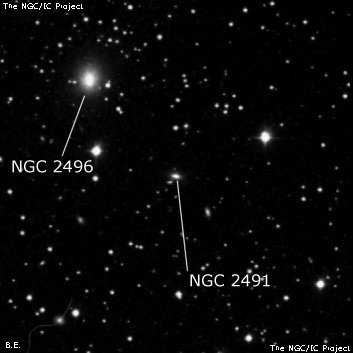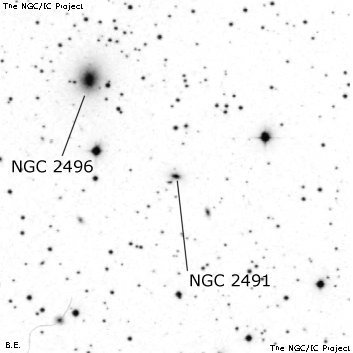NGC/IC Project Restoration Effort
(This is a very very beta version)
NGC2491


Basic Information
Location and Magnitude
Right Ascension: 7:58:27.3
Declination: +7:59:4
Constellation: CMI
Visual Magnitude: 14.8
Historic Information
Discoverer: Swift L.
Year of discovery: 1885
Discovery aperture: 16.0
Observational
Summary description: eeF, pS, irrR, v diffic, B * p
Sub-type: S
Corwin's Notes
=====
NGC 2491 and NGC 2496. Swift saw these as a pair oriented southwest-
northeast, with his position for the brighter (N2496) being within 30 arcsec
of a fairly bright galaxy with a faint star just preceding it. However, Swift
puts the star to the east (following) where there is none. So, I'm going to
suggest that his direction is wrong, but will still keep the galaxy as the one
he saw.
The other galaxy, though, is a problem. The object adopted by RNGC as N2491
(CGCG 031-007) is quite faint, and there are two others 10 arcmin north (CGCG
031-005 and 031-008) that would be easier to pick up: the former is
considerably brighter and larger, while the latter has two stars just
following that would enhance its visibility. These would have been well
within Swift's 33 arcmin field, and should have been more apparent to him than
the RNGC galaxy. In addition, Swift notes a "bright star near west." There
is a 12th magnitude star about 2.5 arcmin to the northwest of CGCG 031-007;
this might qualify as "bright" in a 16-inch refractor, but Swift usually
reserved the word for stars of 10th magnitude or brighter.
So, we have three galaxies to choose from: one matching Swift's position and
(perhaps) his description, and two others that might be more easily seen. One
option is that Swift has confused more than just his direction of the star
near N2496: he confused all of the directions. This would make the
orientation of the two nebulae northwest-southeast, and the bright star would
be east, not west. This would make the star SAO 116199, which -- at 8th
magnitude -- is indeed bright.
The second is to simply accept Swift's positions as did RNGC and say that the
descriptions are confused about the field stars.
Adding to the confusion is Howe's observation of the field. He places N2496
near Swift's place, and notes the star preceding. But then he says, "...
2491, after careful scrutiny on a fine night, resolved itself into a few stars
of mag. 14." The only object in the area matching this description is CGCG
031-008 -- but Howe makes no comment about the 10 arcmin declination error
that must result.
In the end, the identity of NGC 2496 is pretty sure, but that for NGC 2491 is
uncertain enough in my mind to warrant some colons and question marks in the
main table. Perhaps Swift was looking at a completely different pair of
galaxies and simply got his positions wrong. If so, I haven't found the
correct objects yet.
Steve's Notes
=====
NGC 2491
24" (1/31/14): at 375x appeared faint, very small, round, 12" diameter, low even surface brightness. Located 3.7' SW NGC 2496. A mag 11 star is 2.8' NW and a similar star is 2.4' NE.
24" (1/25/14): at 375x appeared very faint to faint, small, elongated 4:3, 20"x15", low even surface brightness. Located 3.7' SW of much brighter NGC 2491. PGC 1335584, an extremely faint galaxy (V = 16.5), was just glimpsed 1.4' SW.



